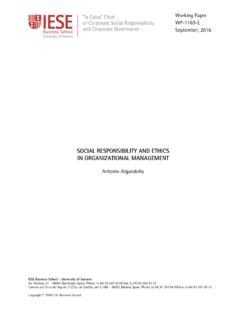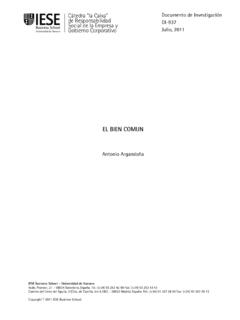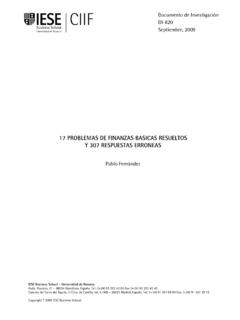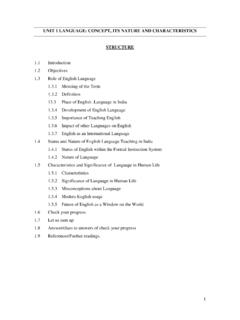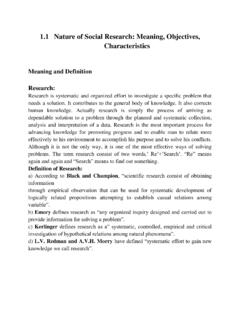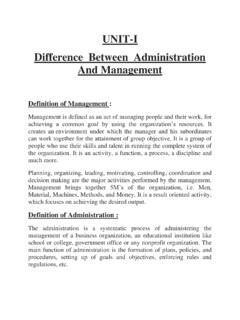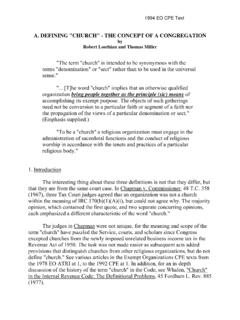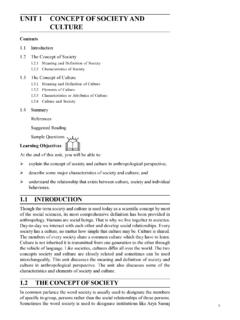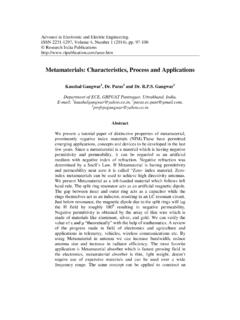Transcription of STRUCTURAL CHARACTERISTICS OF SPORT …
1 IESE Business School-University of Navarra - 1 STRUCTURAL CHARACTERISTICS OF SPORT ORGANIZATIONS: MAIN TRENDS IN THE ACADEMIC DISCUSSION Sandalio G mez Magdalena Opazo Carlos Mart IESE Business School University of Navarra Av. Pearson, 21 08034 Barcelona, Spain. Phone: (+34) 93 253 42 00 Fax: (+34) 93 253 43 43 Camino del Cerro del guila, 3 (Ctra. de Castilla, km 5,180) 28023 Madrid, Spain. Phone: (+34) 91 357 08 09 Fax: (+34) 91 357 29 13 Copyright 2008 IESE Business School. Working PaperWP-704 September, 2007 IESE Business School-University of Navarra STRUCTURAL CHARACTERISTICS OF SPORT ORGANIZATIONS: MAIN TRENDS IN THE ACADEMIC DISCUSSION Sandalio G mez1 Magdalena Opazo2 Carlos Mart 2 Abstract The relation between organizational theory and sports has usually presented sports as an interesting field in which to illustrate organizational phenomenon.
2 This literature review aims to examine academic papers and research which explore the particular nature of organizational phenomenon in sports , specifically in relation to SPORT organizations structure . The topic has been commonly discussed in the context of wider organizational studies, mainly related to organizational change, organizational performance and STRUCTURAL configuration of organizations. This means those changes that have transformed the world of sports have affected not only the structure of SPORT organizations, but also the environment in which they operate and the traditional measures to evaluate their effectiveness. By exploring the literature we may identify future interesting niches for research on SPORT organizations structure as well as the essential elements to be considered when studying organizational phenomenon in the SPORT sector.
3 Keywords: SPORT organizations, structure , literature review. 1 Professor, Managing People in Organizations, IESE 2 Assistant Research, IESE IESE Business School-University of Navarra STRUCTURAL CHARACTERISTICS OF SPORT ORGANIZATIONS: MAIN TRENDS IN THE ACADEMIC DISCUSSION1 Introduction There exists an abundant literature on organizational structure from 1950 onwards. There is Mintzberg s work on typologies of organization based on different STRUCTURAL designs (Mintzberg, 1979), Burns and Stalker s types of organizational structure according to different environmental conditions (Burns and Stalker, 1961), Child s structuring of activities inside the organization (Child, 1972) and Miles s and Snow s conception of structure based on the strategy of the organization (Miles and Snow, 1978), among many others. The interest in studying organizational structure resides in the relationship between organizational design and other organizational phenomena, like performance, distribution of power, or control systems.
4 While there is plenty of literature on organizational structure studying different types of organizations, little is written in books and journals on the specific field of SPORT organizations. Some authors have used sports as a context for illustrating organizational phenomenon such as organizational loyalty, performance, compensation system, escalating commitment, executive succession, sustainable competitive advantage, and human resources, among others. Although research on the particular nature of SPORT organizations and their STRUCTURAL CHARACTERISTICS is still scarce, the article SPORT and Organizational Studies: Exploring synergies (Wolfe et al., 2005) presents a literature review in which they cover a broad spectrum of research studying organizational phenomena in the context of sports . A growing base of knowledge built on experienced-based research is expanding and validating a research field particularly dedicated to SPORT phenomena.
5 The increasing academic interest in the world of sports can be noted in the proliferation of publications and journals looking into sports from a diversity of disciplines ( , history, medicine, psychology, economics, sociology, management), all of which are expanding the knowledge as well as the future opportunities for research and publications on SPORT related topics. Today, sports present an interesting research field for academics, especially because of the increasing relevance that sports have gained in social life, the various changes experienced by the SPORT sector, and the still relatively easy data collection opportunities in this field. 1 This paper was presented at the 14th EASM Congress organized by the European Association of SPORT Management in Nicosia, Cyprus at Intercollege on September 2006. 2 - IESE Business School-University of Navarra Most of the research on SPORT organizations structure has been developed by Trevor Slack and other Canadian academics.
6 In his book on SPORT organizations, Slack gives the following definition of SPORT organizations describing their particular nature: A SPORT organization is a social entity involved in the SPORT industry; it is goal-directed, with a consciously structured activity system and a relatively identifiable boundary (Slack, 1997, p. 5). Though their peculiarities can be attributed to the context in which they operate, it is still a broad definition, allowing many different types of organizations involved in the world of sports to be considered SPORT organizations: public, private and voluntary organizations; for-profit and non-profit organizations; organizations producing sporting goods, delivering SPORT activities, creating competitive SPORT opportunities, and broadcasting SPORT events; as well as many other organizations connected in one way or another to the SPORT industry.
7 Therefore, the first question arising when studying SPORT organizations refers to which type of SPORT organization are we talking about and what different types can be characterized under this broad concept of SPORT organizations. The STRUCTURAL CHARACTERISTICS of an organization are, more often than not, examined in the context of wider organizational studies. The relationship between the structure of the organization to its performance, effectiveness, control system, adaptability, and to the motivation of its members (Hinings et al., 1980) explains the common use of other organizational topics when discussing organizational structure . Since this relationship characterizes traditional organizational studies it may also be likely to characterize research on SPORT organizations. Hence there is a need to clarify the theoretical background in which the discussion on SPORT organizations takes place.
8 The economic transformations, the evolution of telecommunications (Stern, 1979) and the peculiarities of the political system (Amara et al., 2005) have had an impact on both sports and, certainly, SPORT organizations. Changes in the global context within which sports operate affect the internal functioning of the system, their dependence on external resources, the appearance of new communication channels and the support given by the public system. These are all factors that determine the particular CHARACTERISTICS of the context in which SPORT organizations are operating. The question arising therefore refers to which are the most important contextual elements influencing SPORT organizations structure or, in other words, which contextual elements are being considered the most important within the existing research exploring SPORT organizations. The CSBM IESE Business School2 is developing a wider research project regarding the STRUCTURAL CHARACTERISTICS of SPORT organizations in Spain.
9 In order to correctly address this project we first need to know what other authors have written about SPORT organizations structure , what kind of SPORT organizations they have studied, within what theoretical background they have contextualized the discussion on SPORT organizational structure , and which variables they have considered relevant when discussing SPORT organizational structure . The answering of these questions may lead us to identify the state of scholarly knowledge on SPORT organizations structure , as well as uncover interesting niches for our research and other future work in this field. 2 Center for SPORT Business Management (CSBM) IESE Business School, University of Navarra. IESE Business School-University of Navarra - 3 Literature Reviewed In a literature review the collection of data refers to the selection of articles that are going to be analyzed.
10 This literature review considered those articles discussing both structure and SPORT organizations at the same time. Slack (1997, p. 6) defines the structure of a SPORT organization as ..the manner in which the tasks of a SPORT organization are broken down and allocated to employees or volunteers, the reporting relationships among these role holders, and the coordinating and controlling mechanisms used within the SPORT organization. Using this definition, the structure of an organization refers both to the STRUCTURAL design of the organization (differentiation) and to the relationship among actors (coordination and control), which can be associated to the formal structure and the informal structure of an organization. If SPORT organizations are to be considered as all those organizations operating in the SPORT industry, we can include a wide variety of organizations with different goals and means.
